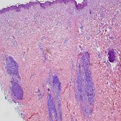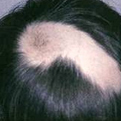Alopecia Areata
General Information
Alopecia Areata (AA) is a recurrent nonscarring type of hair loss that can affect any hair-bearing area. AA is a relatively common condition-affecting individual of any age, mainly patients between the ages of 15 and 40. The cause of AA remains unknown, though much evidence suggests that it is an autoimmune abnormality and is most likely to occur in genetically predisposed individuals. Histologically, lesional biopsies of AA show a perifollicular lymphocytic infiltrate around anagen phase hair follicles. The infiltrate consists mostly of T-helper cells and, to a lesser extent, T-suppressor cells. CD4+ and CD8+ lymphocytes likely play a prominent. Patients with AA demonstrate varying duration and degrees of the disease. Most often asymptomatic around 14% of patients with AA experience a burning sensation or pruritis in the affected area. When the condition first appears, it is localized. Only 80% of patients have a single patch, 12.5% have 2 patches, and 7.7% have multiple patches of hair loss. No correlation exists between the numbers of patches of hair loss from when the patient is first diagnoses to subsequent severity. Treatment is for cosmetic purposes only since the condition is benign, and spontaneous remissions and recurrences are common. Treatment modalities usually are considered first according to the extent of hair loss and the patient’s age.
Epidemiology
Prevalence in the general population is 0.1-0.2% occurring in both males and females
Etiology
Unknown, evidence suggests it is an autoimmune abnormality
Pathogenesis
Affected hair follicles by a peri- and intrafollicular inflammatory cell infiltrate of primarily CD4+ and CD8+ cells localized and patchy hair loss.
Clinical
80% have only a single patch, 12.5% have two patches, and 7.7% have multiple patches.
Histology
Increased number of catagen hairs, associated usually with the presence of early and late anagen hairs, and the presence of empty hair ducts
Bibliography
1. “Alopecia Areata” (Online) June 2005. http://www.emedicine.com/derm/topic14.htm (visited: March 13, 2008) 2. Weeden, David AO, MD, FRCPA Skin Pathology, Second Edition Churchill Livingstone 2002.
Download PDF
![]() Alopecia Areata
Alopecia Areata


